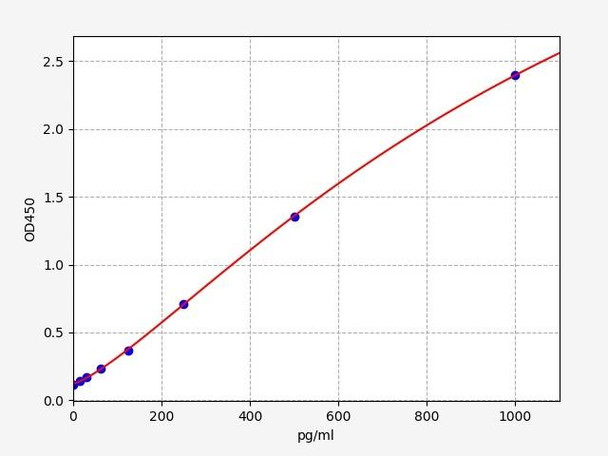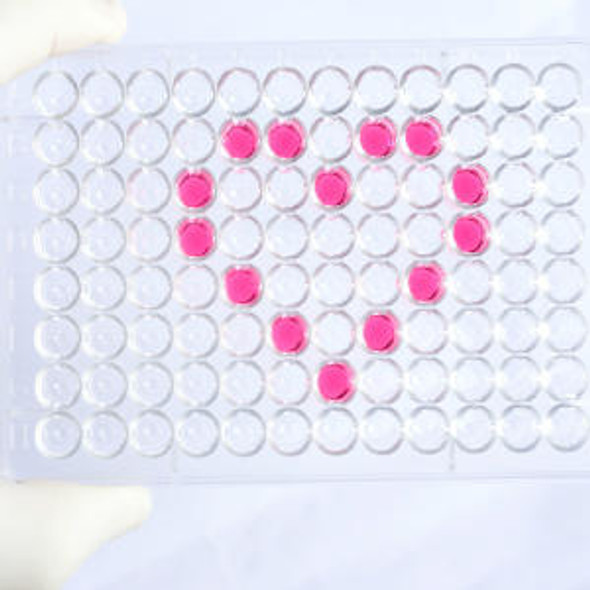Human FOLR1/Folate Receptor alpha ELISA Kit (HUFI00125)
- SKU:
- HUFI00125
- Product Type:
- ELISA Kit
- Size:
- 96 Assays
- Uniprot:
- P15328
- Sensitivity:
- 9.375pg/ml
- Range:
- 15.625-1000pg/ml
- ELISA Type:
- Sandwich
- Synonyms:
- FOLR1, FR-alpha, FBP, Folbp1, Adult folate-binding protein, FBP, folate binding protein, Folate receptor 1
- Reactivity:
- Human
Description
Human FOLR1/Folate Receptor alpha ELISA Kit
The Human FOLR1 (Folate Receptor Alpha) ELISA Kit is specially designed for the accurate measurement of Folate Receptor Alpha levels in human samples such as serum and plasma. This kit offers high sensitivity and specificity, providing reliable and reproducible results for various research applications.Folate Receptor Alpha is an important protein involved in folate uptake and transport in cells, playing a key role in folate metabolism and cell proliferation. Dysregulation of Folate Receptor Alpha has been implicated in various diseases such as cancer, inflammatory disorders, and neurological conditions, making it a valuable biomarker for studying these conditions and exploring potential therapeutic interventions.
With its advanced technology and precise detection capabilities, the Human FOLR1 ELISA Kit is an essential tool for researchers looking to gain insights into the role of Folate Receptor Alpha in health and disease.
| Product Name: | Human FOLR1/Folate Receptor alpha ELISA Kit |
| Product Code: | HUFI00125 |
| Size: | 96 Assays |
| Alias: | FOLR1, FR-alpha, FBP, Folbp1, Adult folate-binding protein, FBP, folate binding protein, Folate receptor 1 |
| Detection method: | Sandwich ELISA, Double Antibody |
| Application: | This immunoassay kit allows for the in vitro quantitative determination of Human FOLR1 concentrations in serum plasma and other biological fluids. |
| Sensitivity: | 9.375pg/ml |
| Range: | 15.625-1000pg/ml |
| Storage: | 4°C for 6 months |
| Note: | For Research Use Only |
| Recovery: | Matrices listed below were spiked with certain level of Human FOLR1 and the recovery rates were calculated by comparing the measured value to the expected amount of Human FOLR1 in samples. | ||||||||||||||||
| |||||||||||||||||
| Linearity: | The linearity of the kit was assayed by testing samples spiked with appropriate concentration of Human FOLR1 and their serial dilutions. The results were demonstrated by the percentage of calculated concentration to the expected. | ||||||||||||||||
| |||||||||||||||||
| CV(%): | Intra-Assay: CV<8% Inter-Assay: CV<10% |
| Component | Quantity | Storage |
| ELISA Microplate (Dismountable) | 8×12 strips | 4°C for 6 months |
| Lyophilized Standard | 2 | 4°C/-20°C |
| Sample/Standard Dilution Buffer | 20ml | 4°C |
| Biotin-labeled Antibody(Concentrated) | 120ul | 4°C (Protect from light) |
| Antibody Dilution Buffer | 10ml | 4°C |
| HRP-Streptavidin Conjugate(SABC) | 120ul | 4°C (Protect from light) |
| SABC Dilution Buffer | 10ml | 4°C |
| TMB Substrate | 10ml | 4°C (Protect from light) |
| Stop Solution | 10ml | 4°C |
| Wash Buffer(25X) | 30ml | 4°C |
| Plate Sealer | 5 | - |
Other materials and equipment required:
- Microplate reader with 450 nm wavelength filter
- Multichannel Pipette, Pipette, microcentrifuge tubes and disposable pipette tips
- Incubator
- Deionized or distilled water
- Absorbent paper
- Buffer resevoir
| Uniprot | P15328 |
| UniProt Protein Function: | FOLR1: Binds to folate and reduced folic acid derivatives and mediates delivery of 5-methyltetrahydrofolate to the interior of cells. Defects in FOLR1 are the cause of neurodegeneration due to cerebral folate transport deficiency (NCFTD). NCFTD is an autosomal recessive disorder resulting from brain- specific folate deficiency early in life. Onset is apparent in late infancy with severe developmental regression, movement disturbances, epilepsy, and leukodystrophy. Recognition and diagnosis of this disorder is critical because folinic acid therapy can reverse the clinical symptoms and improve brain abnormalities and function. Belongs to the folate receptor family. |
| UniProt Protein Details: | Protein type:Membrane protein, GPI anchor Chromosomal Location of Human Ortholog: 11q13.3-q14.1 Cellular Component: anchored to external side of plasma membrane; apical plasma membrane; basolateral plasma membrane; cell surface; endoplasmic reticulum membrane; ER-Golgi intermediate compartment membrane; Golgi membrane; integral to plasma membrane; membrane; nucleus Molecular Function:drug binding; folic acid binding; folic acid transporter activity; methotrexate binding; receptor activity Biological Process: axon regeneration; COPII coating of Golgi vesicle; ER to Golgi vesicle-mediated transport; folic acid transport; heart looping; receptor-mediated endocytosis; regulation of transforming growth factor beta receptor signaling pathway Disease: Neurodegeneration Due To Cerebral Folate Transport Deficiency |
| NCBI Summary: | The protein encoded by this gene is a member of the folate receptor family. Members of this gene family bind folic acid and its reduced derivatives, and transport 5-methyltetrahydrofolate into cells. This gene product is a secreted protein that either anchors to membranes via a glycosyl-phosphatidylinositol linkage or exists in a soluble form. Mutations in this gene have been associated with neurodegeneration due to cerebral folate transport deficiency. Due to the presence of two promoters, multiple transcription start sites, and alternative splicing, multiple transcript variants encoding the same protein have been found for this gene. [provided by RefSeq, Oct 2009] |
| UniProt Code: | P15328 |
| NCBI GenInfo Identifier: | 544337 |
| NCBI Gene ID: | 2348 |
| NCBI Accession: | P15328.3 |
| UniProt Secondary Accession: | P15328,Q53EW2, Q6FGT8, Q6LC90, Q9UCT2, |
| UniProt Related Accession: | P15328 |
| Molecular Weight: | 29,819 Da |
| NCBI Full Name: | Folate receptor alpha |
| NCBI Synonym Full Names: | folate receptor 1 |
| NCBI Official Symbol: | FOLR1 |
| NCBI Official Synonym Symbols: | FBP; FOLR |
| NCBI Protein Information: | folate receptor alpha |
| UniProt Protein Name: | Folate receptor alpha |
| UniProt Synonym Protein Names: | Adult folate-binding protein; FBP; Folate receptor 1; Folate receptor, adult; KB cells FBP; Ovarian tumor-associated antigen MOv18 |
| Protein Family: | Folate receptor |
| UniProt Gene Name: | FOLR1 |
| UniProt Entry Name: | FOLR1_HUMAN |
*Note: Protocols are specific to each batch/lot. For the correct instructions please follow the protocol included in your kit.
Before adding to wells, equilibrate the SABC working solution and TMB substrate for at least 30 min at 37°C. When diluting samples and reagents, they must be mixed completely and evenly. It is recommended to plot a standard curve for each test.
| Step | Protocol |
| 1. | Set standard, test sample and control (zero) wells on the pre-coated plate respectively, and then, record their positions. It is recommended to measure each standard and sample in duplicate. Wash plate 2 times before adding standard, sample and control (zero) wells! |
| 2. | Aliquot 0.1ml standard solutions into the standard wells. |
| 3. | Add 0.1 ml of Sample / Standard dilution buffer into the control (zero) well. |
| 4. | Add 0.1 ml of properly diluted sample ( Human serum, plasma, tissue homogenates and other biological fluids.) into test sample wells. |
| 5. | Seal the plate with a cover and incubate at 37 °C for 90 min. |
| 6. | Remove the cover and discard the plate content, clap the plate on the absorbent filter papers or other absorbent material. Do NOT let the wells completely dry at any time. Wash plate X2. |
| 7. | Add 0.1 ml of Biotin- detection antibody working solution into the above wells (standard, test sample & zero wells). Add the solution at the bottom of each well without touching the side wall. |
| 8. | Seal the plate with a cover and incubate at 37°C for 60 min. |
| 9. | Remove the cover, and wash plate 3 times with Wash buffer. Let wash buffer rest in wells for 1 min between each wash. |
| 10. | Add 0.1 ml of SABC working solution into each well, cover the plate and incubate at 37°C for 30 min. |
| 11. | Remove the cover and wash plate 5 times with Wash buffer, and each time let the wash buffer stay in the wells for 1-2 min. |
| 12. | Add 90 µl of TMB substrate into each well, cover the plate and incubate at 37°C in dark within 10-20 min. (Note: This incubation time is for reference use only, the optimal time should be determined by end user.) And the shades of blue can be seen in the first 3-4 wells (with most concentrated standard solutions), the other wells show no obvious color. |
| 13. | Add 50 µl of Stop solution into each well and mix thoroughly. The color changes into yellow immediately. |
| 14. | Read the O.D. absorbance at 450 nm in a microplate reader immediately after adding the stop solution. |
When carrying out an ELISA assay it is important to prepare your samples in order to achieve the best possible results. Below we have a list of procedures for the preparation of samples for different sample types.
| Sample Type | Protocol |
| Serum | If using serum separator tubes, allow samples to clot for 30 minutes at room temperature. Centrifuge for 10 minutes at 1,000x g. Collect the serum fraction and assay promptly or aliquot and store the samples at -80°C. Avoid multiple freeze-thaw cycles. If serum separator tubes are not being used, allow samples to clot overnight at 2-8°C. Centrifuge for 10 minutes at 1,000x g. Remove serum and assay promptly or aliquot and store the samples at -80°C. Avoid multiple freeze-thaw cycles. |
| Plasma | Collect plasma using EDTA or heparin as an anticoagulant. Centrifuge samples at 4°C for 15 mins at 1000 × g within 30 mins of collection. Collect the plasma fraction and assay promptly or aliquot and store the samples at -80°C. Avoid multiple freeze-thaw cycles. Note: Over haemolysed samples are not suitable for use with this kit. |
| Urine & Cerebrospinal Fluid | Collect the urine (mid-stream) in a sterile container, centrifuge for 20 mins at 2000-3000 rpm. Remove supernatant and assay immediately. If any precipitation is detected, repeat the centrifugation step. A similar protocol can be used for cerebrospinal fluid. |
| Cell culture supernatant | Collect the cell culture media by pipette, followed by centrifugation at 4°C for 20 mins at 1500 rpm. Collect the clear supernatant and assay immediately. |
| Cell lysates | Solubilize cells in lysis buffer and allow to sit on ice for 30 minutes. Centrifuge tubes at 14,000 x g for 5 minutes to remove insoluble material. Aliquot the supernatant into a new tube and discard the remaining whole cell extract. Quantify total protein concentration using a total protein assay. Assay immediately or aliquot and store at ≤ -20 °C. |
| Tissue homogenates | The preparation of tissue homogenates will vary depending upon tissue type. Rinse tissue with 1X PBS to remove excess blood & homogenize in 20ml of 1X PBS (including protease inhibitors) and store overnight at ≤ -20°C. Two freeze-thaw cycles are required to break the cell membranes. To further disrupt the cell membranes you can sonicate the samples. Centrifuge homogenates for 5 mins at 5000xg. Remove the supernatant and assay immediately or aliquot and store at -20°C or -80°C. |
| Tissue lysates | Rinse tissue with PBS, cut into 1-2 mm pieces, and homogenize with a tissue homogenizer in PBS. Add an equal volume of RIPA buffer containing protease inhibitors and lyse tissues at room temperature for 30 minutes with gentle agitation. Centrifuge to remove debris. Quantify total protein concentration using a total protein assay. Assay immediately or aliquot and store at ≤ -20 °C. |
| Breast Milk | Collect milk samples and centrifuge at 10,000 x g for 60 min at 4°C. Aliquot the supernatant and assay. For long term use, store samples at -80°C. Minimize freeze/thaw cycles. |






